Anatomy and Physiology in Healthcare Settings
VerifiedAdded on 2022/08/08
|11
|3079
|166
AI Summary
Unit title & code NUR015-1 Assignment number and title 001 Assessment type Essay Weighting of assessment 50% Unit learning outcomes On completion of this essay you would be able to 1. Demonstrate an understanding of anatomy and physiology and its application to health and health care 2. Discuss the meaning of health and well-being from a range of perspectives including relevant biological, psychological and sociological ones 3. Outline and explain the ways in which health promotion can contribute to the improved health and well being of individuals, groups and the population as a whole 4. Discuss the interaction between physical and psychological health and wellbeing and the impact life experiences may have on both What am I required to do in this assignment? • You are required to submit an academic essay focusing upon a patient whose care you have been involved in during placement 1a.
Contribute Materials
Your contribution can guide someone’s learning journey. Share your
documents today.
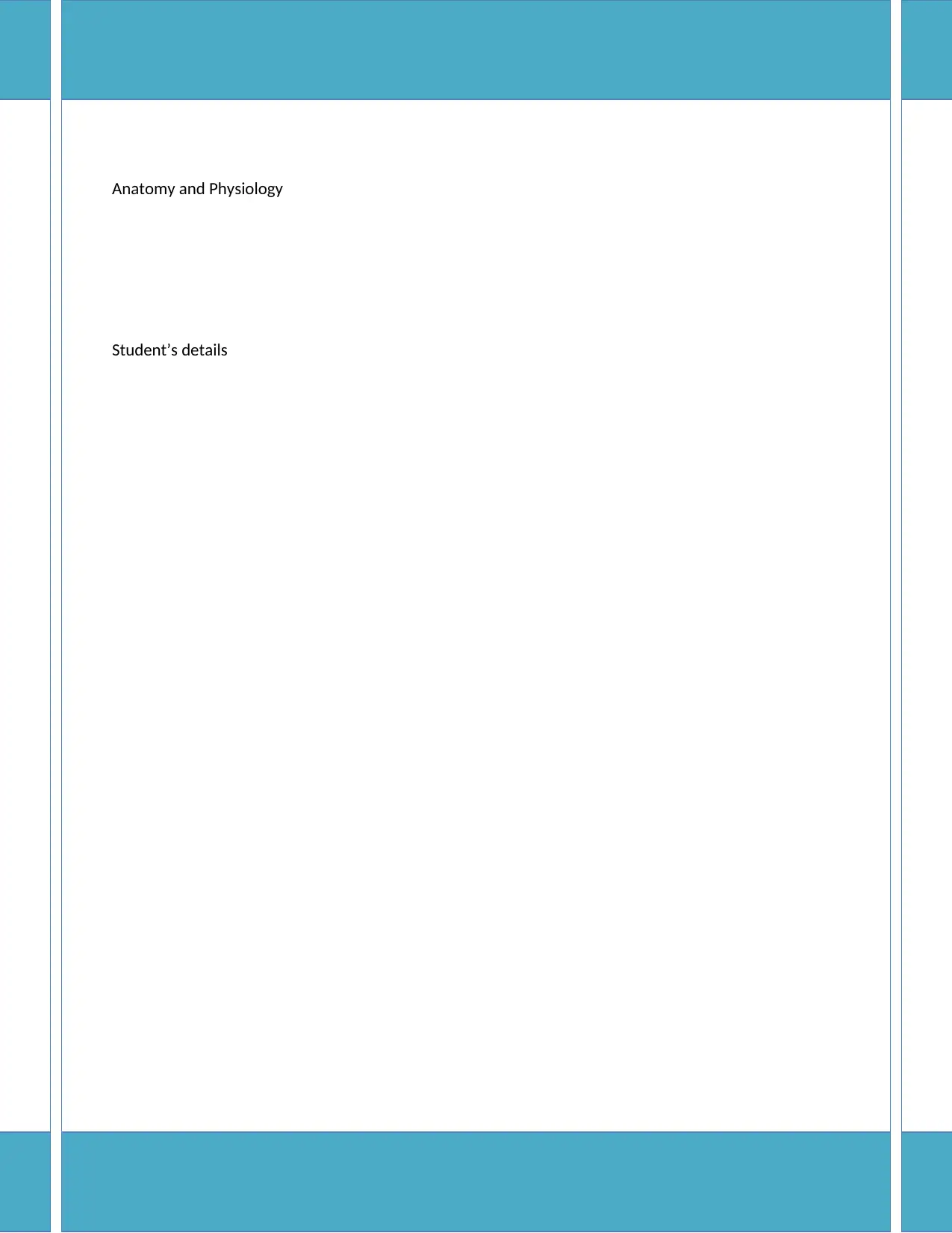
Anatomy and Physiology
Student’s details
Student’s details
Secure Best Marks with AI Grader
Need help grading? Try our AI Grader for instant feedback on your assignments.
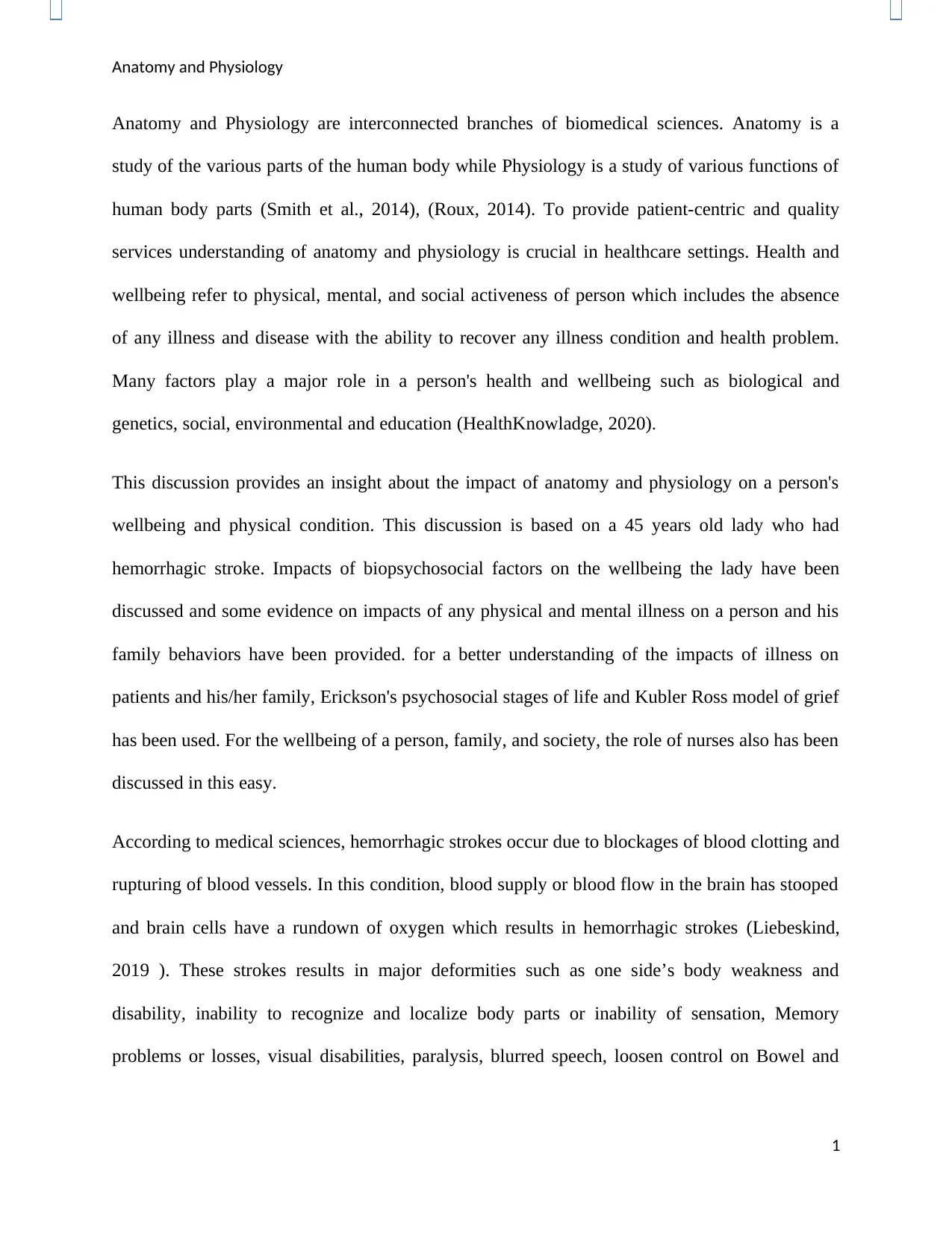
Anatomy and Physiology
Anatomy and Physiology are interconnected branches of biomedical sciences. Anatomy is a
study of the various parts of the human body while Physiology is a study of various functions of
human body parts (Smith et al., 2014), (Roux, 2014). To provide patient-centric and quality
services understanding of anatomy and physiology is crucial in healthcare settings. Health and
wellbeing refer to physical, mental, and social activeness of person which includes the absence
of any illness and disease with the ability to recover any illness condition and health problem.
Many factors play a major role in a person's health and wellbeing such as biological and
genetics, social, environmental and education (HealthKnowladge, 2020).
This discussion provides an insight about the impact of anatomy and physiology on a person's
wellbeing and physical condition. This discussion is based on a 45 years old lady who had
hemorrhagic stroke. Impacts of biopsychosocial factors on the wellbeing the lady have been
discussed and some evidence on impacts of any physical and mental illness on a person and his
family behaviors have been provided. for a better understanding of the impacts of illness on
patients and his/her family, Erickson's psychosocial stages of life and Kubler Ross model of grief
has been used. For the wellbeing of a person, family, and society, the role of nurses also has been
discussed in this easy.
According to medical sciences, hemorrhagic strokes occur due to blockages of blood clotting and
rupturing of blood vessels. In this condition, blood supply or blood flow in the brain has stooped
and brain cells have a rundown of oxygen which results in hemorrhagic strokes (Liebeskind,
2019 ). These strokes results in major deformities such as one side’s body weakness and
disability, inability to recognize and localize body parts or inability of sensation, Memory
problems or losses, visual disabilities, paralysis, blurred speech, loosen control on Bowel and
1
Anatomy and Physiology are interconnected branches of biomedical sciences. Anatomy is a
study of the various parts of the human body while Physiology is a study of various functions of
human body parts (Smith et al., 2014), (Roux, 2014). To provide patient-centric and quality
services understanding of anatomy and physiology is crucial in healthcare settings. Health and
wellbeing refer to physical, mental, and social activeness of person which includes the absence
of any illness and disease with the ability to recover any illness condition and health problem.
Many factors play a major role in a person's health and wellbeing such as biological and
genetics, social, environmental and education (HealthKnowladge, 2020).
This discussion provides an insight about the impact of anatomy and physiology on a person's
wellbeing and physical condition. This discussion is based on a 45 years old lady who had
hemorrhagic stroke. Impacts of biopsychosocial factors on the wellbeing the lady have been
discussed and some evidence on impacts of any physical and mental illness on a person and his
family behaviors have been provided. for a better understanding of the impacts of illness on
patients and his/her family, Erickson's psychosocial stages of life and Kubler Ross model of grief
has been used. For the wellbeing of a person, family, and society, the role of nurses also has been
discussed in this easy.
According to medical sciences, hemorrhagic strokes occur due to blockages of blood clotting and
rupturing of blood vessels. In this condition, blood supply or blood flow in the brain has stooped
and brain cells have a rundown of oxygen which results in hemorrhagic strokes (Liebeskind,
2019 ). These strokes results in major deformities such as one side’s body weakness and
disability, inability to recognize and localize body parts or inability of sensation, Memory
problems or losses, visual disabilities, paralysis, blurred speech, loosen control on Bowel and
1
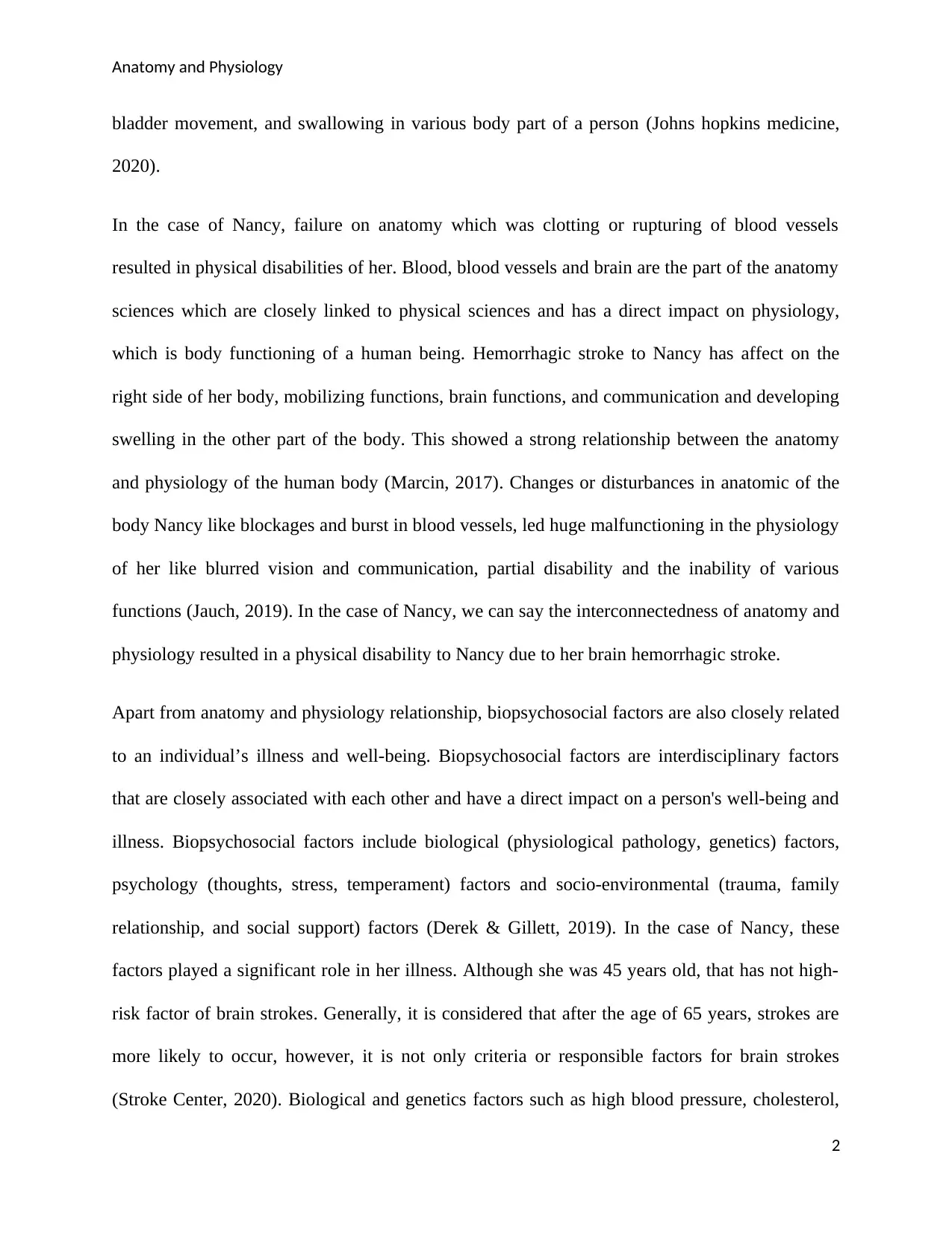
Anatomy and Physiology
bladder movement, and swallowing in various body part of a person (Johns hopkins medicine,
2020).
In the case of Nancy, failure on anatomy which was clotting or rupturing of blood vessels
resulted in physical disabilities of her. Blood, blood vessels and brain are the part of the anatomy
sciences which are closely linked to physical sciences and has a direct impact on physiology,
which is body functioning of a human being. Hemorrhagic stroke to Nancy has affect on the
right side of her body, mobilizing functions, brain functions, and communication and developing
swelling in the other part of the body. This showed a strong relationship between the anatomy
and physiology of the human body (Marcin, 2017). Changes or disturbances in anatomic of the
body Nancy like blockages and burst in blood vessels, led huge malfunctioning in the physiology
of her like blurred vision and communication, partial disability and the inability of various
functions (Jauch, 2019). In the case of Nancy, we can say the interconnectedness of anatomy and
physiology resulted in a physical disability to Nancy due to her brain hemorrhagic stroke.
Apart from anatomy and physiology relationship, biopsychosocial factors are also closely related
to an individual’s illness and well-being. Biopsychosocial factors are interdisciplinary factors
that are closely associated with each other and have a direct impact on a person's well-being and
illness. Biopsychosocial factors include biological (physiological pathology, genetics) factors,
psychology (thoughts, stress, temperament) factors and socio-environmental (trauma, family
relationship, and social support) factors (Derek & Gillett, 2019). In the case of Nancy, these
factors played a significant role in her illness. Although she was 45 years old, that has not high-
risk factor of brain strokes. Generally, it is considered that after the age of 65 years, strokes are
more likely to occur, however, it is not only criteria or responsible factors for brain strokes
(Stroke Center, 2020). Biological and genetics factors such as high blood pressure, cholesterol,
2
bladder movement, and swallowing in various body part of a person (Johns hopkins medicine,
2020).
In the case of Nancy, failure on anatomy which was clotting or rupturing of blood vessels
resulted in physical disabilities of her. Blood, blood vessels and brain are the part of the anatomy
sciences which are closely linked to physical sciences and has a direct impact on physiology,
which is body functioning of a human being. Hemorrhagic stroke to Nancy has affect on the
right side of her body, mobilizing functions, brain functions, and communication and developing
swelling in the other part of the body. This showed a strong relationship between the anatomy
and physiology of the human body (Marcin, 2017). Changes or disturbances in anatomic of the
body Nancy like blockages and burst in blood vessels, led huge malfunctioning in the physiology
of her like blurred vision and communication, partial disability and the inability of various
functions (Jauch, 2019). In the case of Nancy, we can say the interconnectedness of anatomy and
physiology resulted in a physical disability to Nancy due to her brain hemorrhagic stroke.
Apart from anatomy and physiology relationship, biopsychosocial factors are also closely related
to an individual’s illness and well-being. Biopsychosocial factors are interdisciplinary factors
that are closely associated with each other and have a direct impact on a person's well-being and
illness. Biopsychosocial factors include biological (physiological pathology, genetics) factors,
psychology (thoughts, stress, temperament) factors and socio-environmental (trauma, family
relationship, and social support) factors (Derek & Gillett, 2019). In the case of Nancy, these
factors played a significant role in her illness. Although she was 45 years old, that has not high-
risk factor of brain strokes. Generally, it is considered that after the age of 65 years, strokes are
more likely to occur, however, it is not only criteria or responsible factors for brain strokes
(Stroke Center, 2020). Biological and genetics factors such as high blood pressure, cholesterol,
2
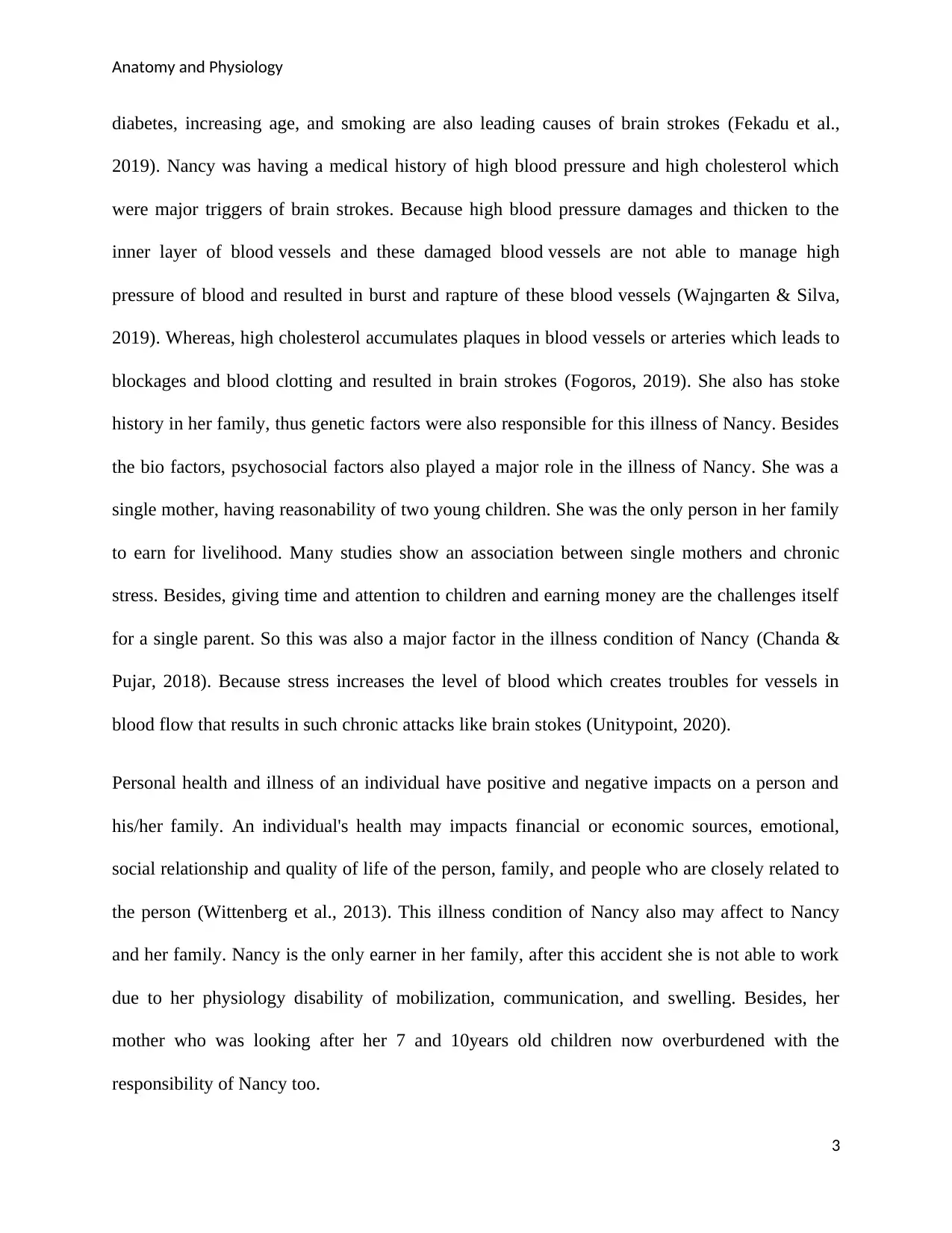
Anatomy and Physiology
diabetes, increasing age, and smoking are also leading causes of brain strokes (Fekadu et al.,
2019). Nancy was having a medical history of high blood pressure and high cholesterol which
were major triggers of brain strokes. Because high blood pressure damages and thicken to the
inner layer of blood vessels and these damaged blood vessels are not able to manage high
pressure of blood and resulted in burst and rapture of these blood vessels (Wajngarten & Silva,
2019). Whereas, high cholesterol accumulates plaques in blood vessels or arteries which leads to
blockages and blood clotting and resulted in brain strokes (Fogoros, 2019). She also has stoke
history in her family, thus genetic factors were also responsible for this illness of Nancy. Besides
the bio factors, psychosocial factors also played a major role in the illness of Nancy. She was a
single mother, having reasonability of two young children. She was the only person in her family
to earn for livelihood. Many studies show an association between single mothers and chronic
stress. Besides, giving time and attention to children and earning money are the challenges itself
for a single parent. So this was also a major factor in the illness condition of Nancy (Chanda &
Pujar, 2018). Because stress increases the level of blood which creates troubles for vessels in
blood flow that results in such chronic attacks like brain stokes (Unitypoint, 2020).
Personal health and illness of an individual have positive and negative impacts on a person and
his/her family. An individual's health may impacts financial or economic sources, emotional,
social relationship and quality of life of the person, family, and people who are closely related to
the person (Wittenberg et al., 2013). This illness condition of Nancy also may affect to Nancy
and her family. Nancy is the only earner in her family, after this accident she is not able to work
due to her physiology disability of mobilization, communication, and swelling. Besides, her
mother who was looking after her 7 and 10years old children now overburdened with the
responsibility of Nancy too.
3
diabetes, increasing age, and smoking are also leading causes of brain strokes (Fekadu et al.,
2019). Nancy was having a medical history of high blood pressure and high cholesterol which
were major triggers of brain strokes. Because high blood pressure damages and thicken to the
inner layer of blood vessels and these damaged blood vessels are not able to manage high
pressure of blood and resulted in burst and rapture of these blood vessels (Wajngarten & Silva,
2019). Whereas, high cholesterol accumulates plaques in blood vessels or arteries which leads to
blockages and blood clotting and resulted in brain strokes (Fogoros, 2019). She also has stoke
history in her family, thus genetic factors were also responsible for this illness of Nancy. Besides
the bio factors, psychosocial factors also played a major role in the illness of Nancy. She was a
single mother, having reasonability of two young children. She was the only person in her family
to earn for livelihood. Many studies show an association between single mothers and chronic
stress. Besides, giving time and attention to children and earning money are the challenges itself
for a single parent. So this was also a major factor in the illness condition of Nancy (Chanda &
Pujar, 2018). Because stress increases the level of blood which creates troubles for vessels in
blood flow that results in such chronic attacks like brain stokes (Unitypoint, 2020).
Personal health and illness of an individual have positive and negative impacts on a person and
his/her family. An individual's health may impacts financial or economic sources, emotional,
social relationship and quality of life of the person, family, and people who are closely related to
the person (Wittenberg et al., 2013). This illness condition of Nancy also may affect to Nancy
and her family. Nancy is the only earner in her family, after this accident she is not able to work
due to her physiology disability of mobilization, communication, and swelling. Besides, her
mother who was looking after her 7 and 10years old children now overburdened with the
responsibility of Nancy too.
3
Secure Best Marks with AI Grader
Need help grading? Try our AI Grader for instant feedback on your assignments.
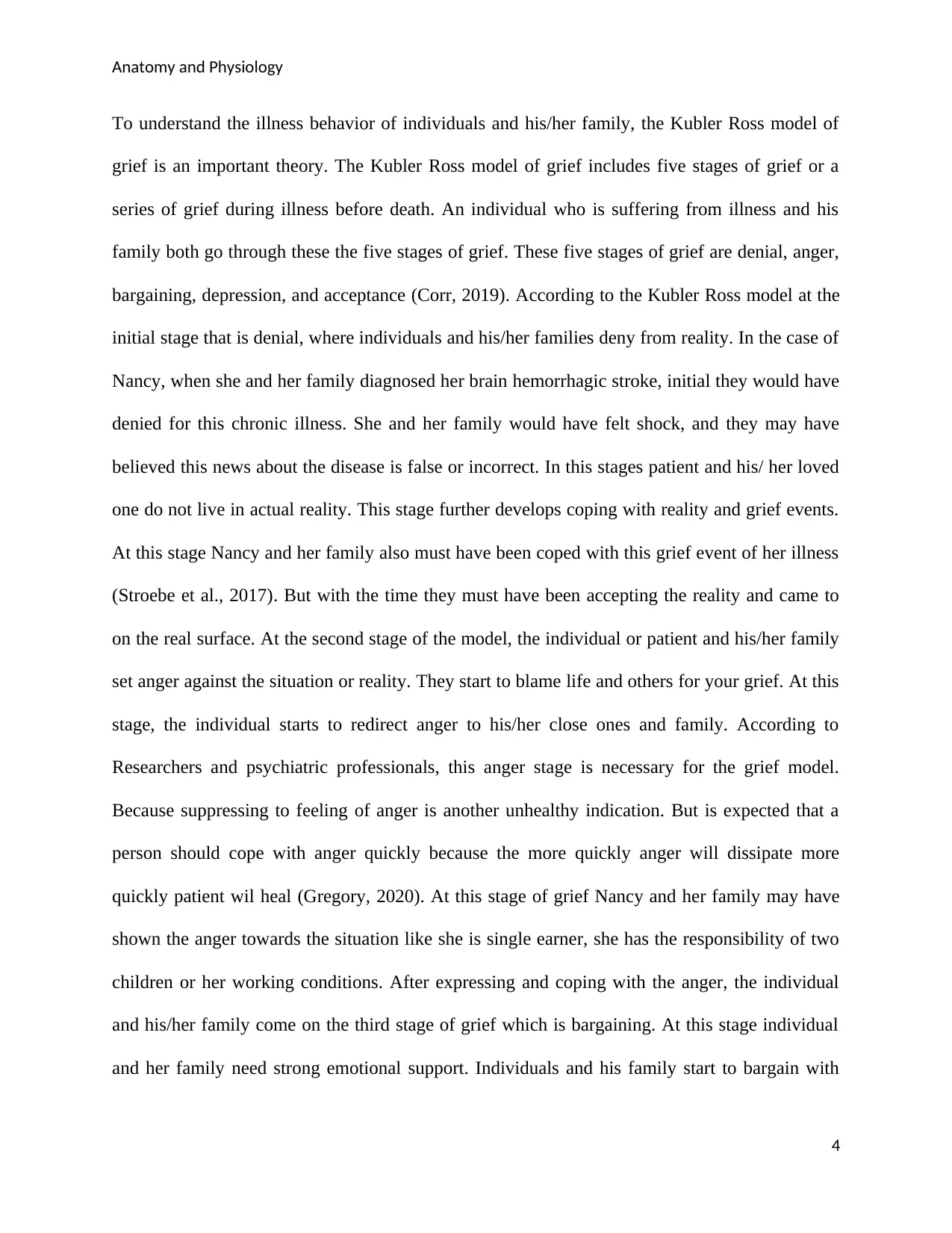
Anatomy and Physiology
To understand the illness behavior of individuals and his/her family, the Kubler Ross model of
grief is an important theory. The Kubler Ross model of grief includes five stages of grief or a
series of grief during illness before death. An individual who is suffering from illness and his
family both go through these the five stages of grief. These five stages of grief are denial, anger,
bargaining, depression, and acceptance (Corr, 2019). According to the Kubler Ross model at the
initial stage that is denial, where individuals and his/her families deny from reality. In the case of
Nancy, when she and her family diagnosed her brain hemorrhagic stroke, initial they would have
denied for this chronic illness. She and her family would have felt shock, and they may have
believed this news about the disease is false or incorrect. In this stages patient and his/ her loved
one do not live in actual reality. This stage further develops coping with reality and grief events.
At this stage Nancy and her family also must have been coped with this grief event of her illness
(Stroebe et al., 2017). But with the time they must have been accepting the reality and came to
on the real surface. At the second stage of the model, the individual or patient and his/her family
set anger against the situation or reality. They start to blame life and others for your grief. At this
stage, the individual starts to redirect anger to his/her close ones and family. According to
Researchers and psychiatric professionals, this anger stage is necessary for the grief model.
Because suppressing to feeling of anger is another unhealthy indication. But is expected that a
person should cope with anger quickly because the more quickly anger will dissipate more
quickly patient wil heal (Gregory, 2020). At this stage of grief Nancy and her family may have
shown the anger towards the situation like she is single earner, she has the responsibility of two
children or her working conditions. After expressing and coping with the anger, the individual
and his/her family come on the third stage of grief which is bargaining. At this stage individual
and her family need strong emotional support. Individuals and his family start to bargain with
4
To understand the illness behavior of individuals and his/her family, the Kubler Ross model of
grief is an important theory. The Kubler Ross model of grief includes five stages of grief or a
series of grief during illness before death. An individual who is suffering from illness and his
family both go through these the five stages of grief. These five stages of grief are denial, anger,
bargaining, depression, and acceptance (Corr, 2019). According to the Kubler Ross model at the
initial stage that is denial, where individuals and his/her families deny from reality. In the case of
Nancy, when she and her family diagnosed her brain hemorrhagic stroke, initial they would have
denied for this chronic illness. She and her family would have felt shock, and they may have
believed this news about the disease is false or incorrect. In this stages patient and his/ her loved
one do not live in actual reality. This stage further develops coping with reality and grief events.
At this stage Nancy and her family also must have been coped with this grief event of her illness
(Stroebe et al., 2017). But with the time they must have been accepting the reality and came to
on the real surface. At the second stage of the model, the individual or patient and his/her family
set anger against the situation or reality. They start to blame life and others for your grief. At this
stage, the individual starts to redirect anger to his/her close ones and family. According to
Researchers and psychiatric professionals, this anger stage is necessary for the grief model.
Because suppressing to feeling of anger is another unhealthy indication. But is expected that a
person should cope with anger quickly because the more quickly anger will dissipate more
quickly patient wil heal (Gregory, 2020). At this stage of grief Nancy and her family may have
shown the anger towards the situation like she is single earner, she has the responsibility of two
children or her working conditions. After expressing and coping with the anger, the individual
and his/her family come on the third stage of grief which is bargaining. At this stage individual
and her family need strong emotional support. Individuals and his family start to bargain with
4
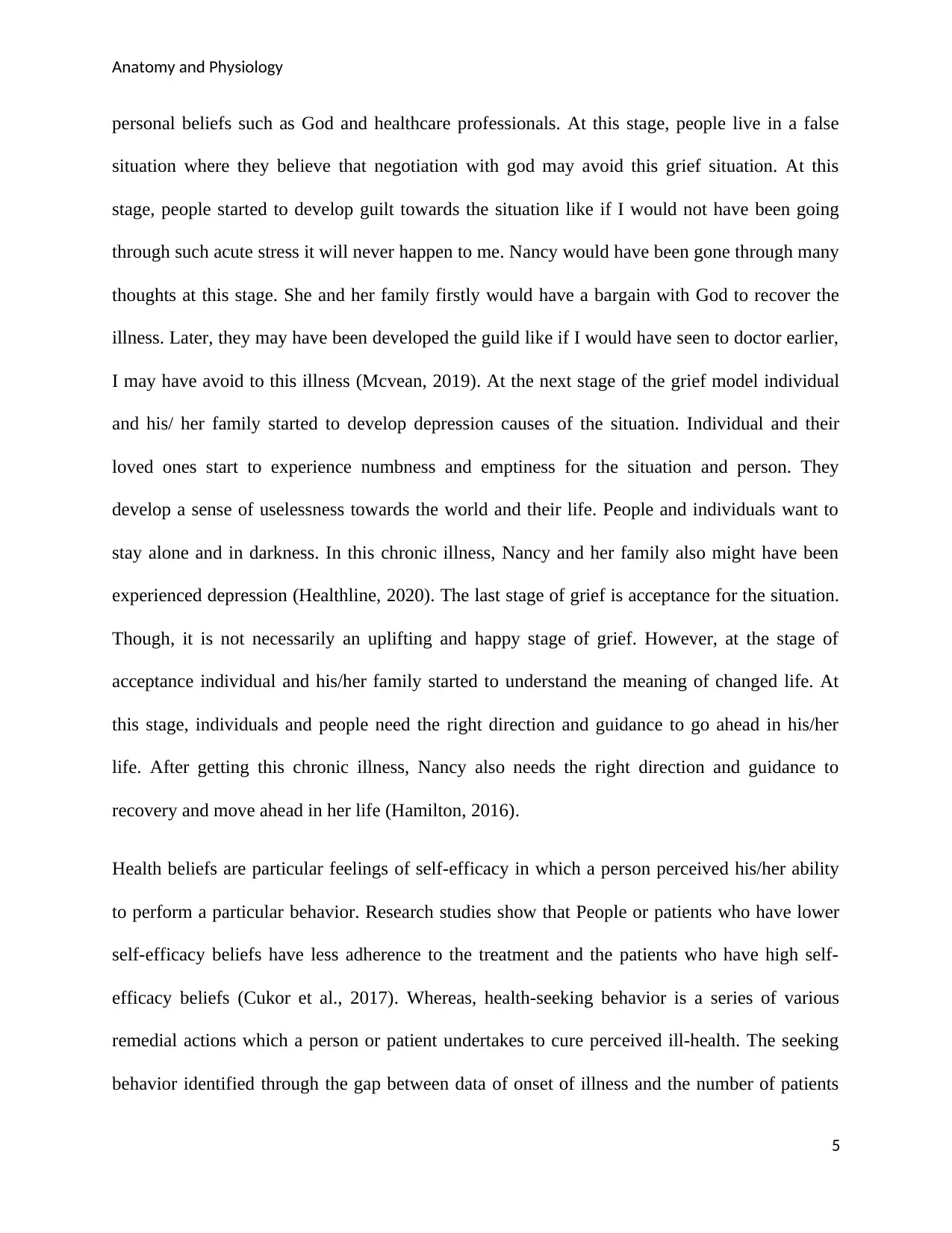
Anatomy and Physiology
personal beliefs such as God and healthcare professionals. At this stage, people live in a false
situation where they believe that negotiation with god may avoid this grief situation. At this
stage, people started to develop guilt towards the situation like if I would not have been going
through such acute stress it will never happen to me. Nancy would have been gone through many
thoughts at this stage. She and her family firstly would have a bargain with God to recover the
illness. Later, they may have been developed the guild like if I would have seen to doctor earlier,
I may have avoid to this illness (Mcvean, 2019). At the next stage of the grief model individual
and his/ her family started to develop depression causes of the situation. Individual and their
loved ones start to experience numbness and emptiness for the situation and person. They
develop a sense of uselessness towards the world and their life. People and individuals want to
stay alone and in darkness. In this chronic illness, Nancy and her family also might have been
experienced depression (Healthline, 2020). The last stage of grief is acceptance for the situation.
Though, it is not necessarily an uplifting and happy stage of grief. However, at the stage of
acceptance individual and his/her family started to understand the meaning of changed life. At
this stage, individuals and people need the right direction and guidance to go ahead in his/her
life. After getting this chronic illness, Nancy also needs the right direction and guidance to
recovery and move ahead in her life (Hamilton, 2016).
Health beliefs are particular feelings of self-efficacy in which a person perceived his/her ability
to perform a particular behavior. Research studies show that People or patients who have lower
self-efficacy beliefs have less adherence to the treatment and the patients who have high self-
efficacy beliefs (Cukor et al., 2017). Whereas, health-seeking behavior is a series of various
remedial actions which a person or patient undertakes to cure perceived ill-health. The seeking
behavior identified through the gap between data of onset of illness and the number of patients
5
personal beliefs such as God and healthcare professionals. At this stage, people live in a false
situation where they believe that negotiation with god may avoid this grief situation. At this
stage, people started to develop guilt towards the situation like if I would not have been going
through such acute stress it will never happen to me. Nancy would have been gone through many
thoughts at this stage. She and her family firstly would have a bargain with God to recover the
illness. Later, they may have been developed the guild like if I would have seen to doctor earlier,
I may have avoid to this illness (Mcvean, 2019). At the next stage of the grief model individual
and his/ her family started to develop depression causes of the situation. Individual and their
loved ones start to experience numbness and emptiness for the situation and person. They
develop a sense of uselessness towards the world and their life. People and individuals want to
stay alone and in darkness. In this chronic illness, Nancy and her family also might have been
experienced depression (Healthline, 2020). The last stage of grief is acceptance for the situation.
Though, it is not necessarily an uplifting and happy stage of grief. However, at the stage of
acceptance individual and his/her family started to understand the meaning of changed life. At
this stage, individuals and people need the right direction and guidance to go ahead in his/her
life. After getting this chronic illness, Nancy also needs the right direction and guidance to
recovery and move ahead in her life (Hamilton, 2016).
Health beliefs are particular feelings of self-efficacy in which a person perceived his/her ability
to perform a particular behavior. Research studies show that People or patients who have lower
self-efficacy beliefs have less adherence to the treatment and the patients who have high self-
efficacy beliefs (Cukor et al., 2017). Whereas, health-seeking behavior is a series of various
remedial actions which a person or patient undertakes to cure perceived ill-health. The seeking
behavior identified through the gap between data of onset of illness and the number of patients
5
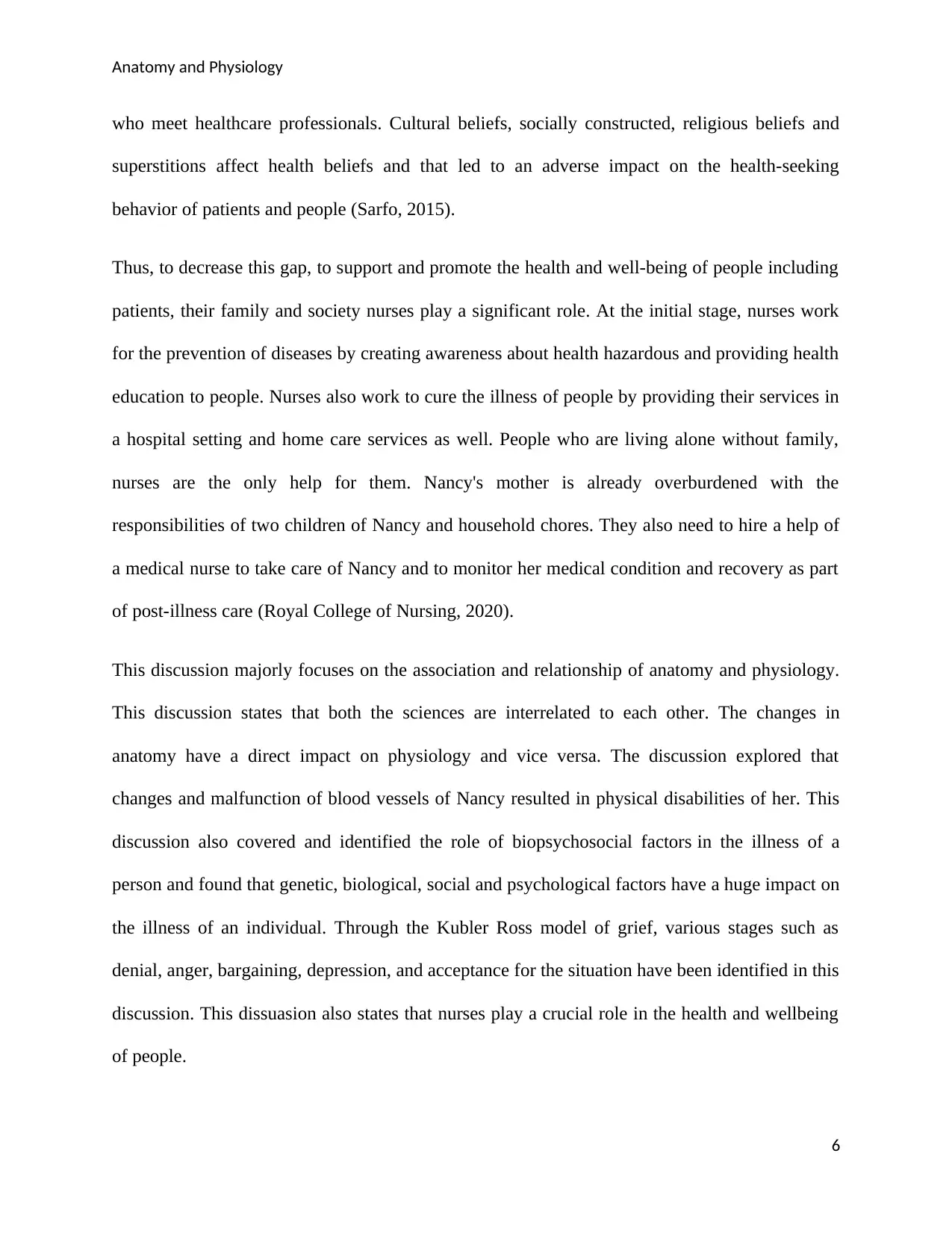
Anatomy and Physiology
who meet healthcare professionals. Cultural beliefs, socially constructed, religious beliefs and
superstitions affect health beliefs and that led to an adverse impact on the health-seeking
behavior of patients and people (Sarfo, 2015).
Thus, to decrease this gap, to support and promote the health and well-being of people including
patients, their family and society nurses play a significant role. At the initial stage, nurses work
for the prevention of diseases by creating awareness about health hazardous and providing health
education to people. Nurses also work to cure the illness of people by providing their services in
a hospital setting and home care services as well. People who are living alone without family,
nurses are the only help for them. Nancy's mother is already overburdened with the
responsibilities of two children of Nancy and household chores. They also need to hire a help of
a medical nurse to take care of Nancy and to monitor her medical condition and recovery as part
of post-illness care (Royal College of Nursing, 2020).
This discussion majorly focuses on the association and relationship of anatomy and physiology.
This discussion states that both the sciences are interrelated to each other. The changes in
anatomy have a direct impact on physiology and vice versa. The discussion explored that
changes and malfunction of blood vessels of Nancy resulted in physical disabilities of her. This
discussion also covered and identified the role of biopsychosocial factors in the illness of a
person and found that genetic, biological, social and psychological factors have a huge impact on
the illness of an individual. Through the Kubler Ross model of grief, various stages such as
denial, anger, bargaining, depression, and acceptance for the situation have been identified in this
discussion. This dissuasion also states that nurses play a crucial role in the health and wellbeing
of people.
6
who meet healthcare professionals. Cultural beliefs, socially constructed, religious beliefs and
superstitions affect health beliefs and that led to an adverse impact on the health-seeking
behavior of patients and people (Sarfo, 2015).
Thus, to decrease this gap, to support and promote the health and well-being of people including
patients, their family and society nurses play a significant role. At the initial stage, nurses work
for the prevention of diseases by creating awareness about health hazardous and providing health
education to people. Nurses also work to cure the illness of people by providing their services in
a hospital setting and home care services as well. People who are living alone without family,
nurses are the only help for them. Nancy's mother is already overburdened with the
responsibilities of two children of Nancy and household chores. They also need to hire a help of
a medical nurse to take care of Nancy and to monitor her medical condition and recovery as part
of post-illness care (Royal College of Nursing, 2020).
This discussion majorly focuses on the association and relationship of anatomy and physiology.
This discussion states that both the sciences are interrelated to each other. The changes in
anatomy have a direct impact on physiology and vice versa. The discussion explored that
changes and malfunction of blood vessels of Nancy resulted in physical disabilities of her. This
discussion also covered and identified the role of biopsychosocial factors in the illness of a
person and found that genetic, biological, social and psychological factors have a huge impact on
the illness of an individual. Through the Kubler Ross model of grief, various stages such as
denial, anger, bargaining, depression, and acceptance for the situation have been identified in this
discussion. This dissuasion also states that nurses play a crucial role in the health and wellbeing
of people.
6
Paraphrase This Document
Need a fresh take? Get an instant paraphrase of this document with our AI Paraphraser
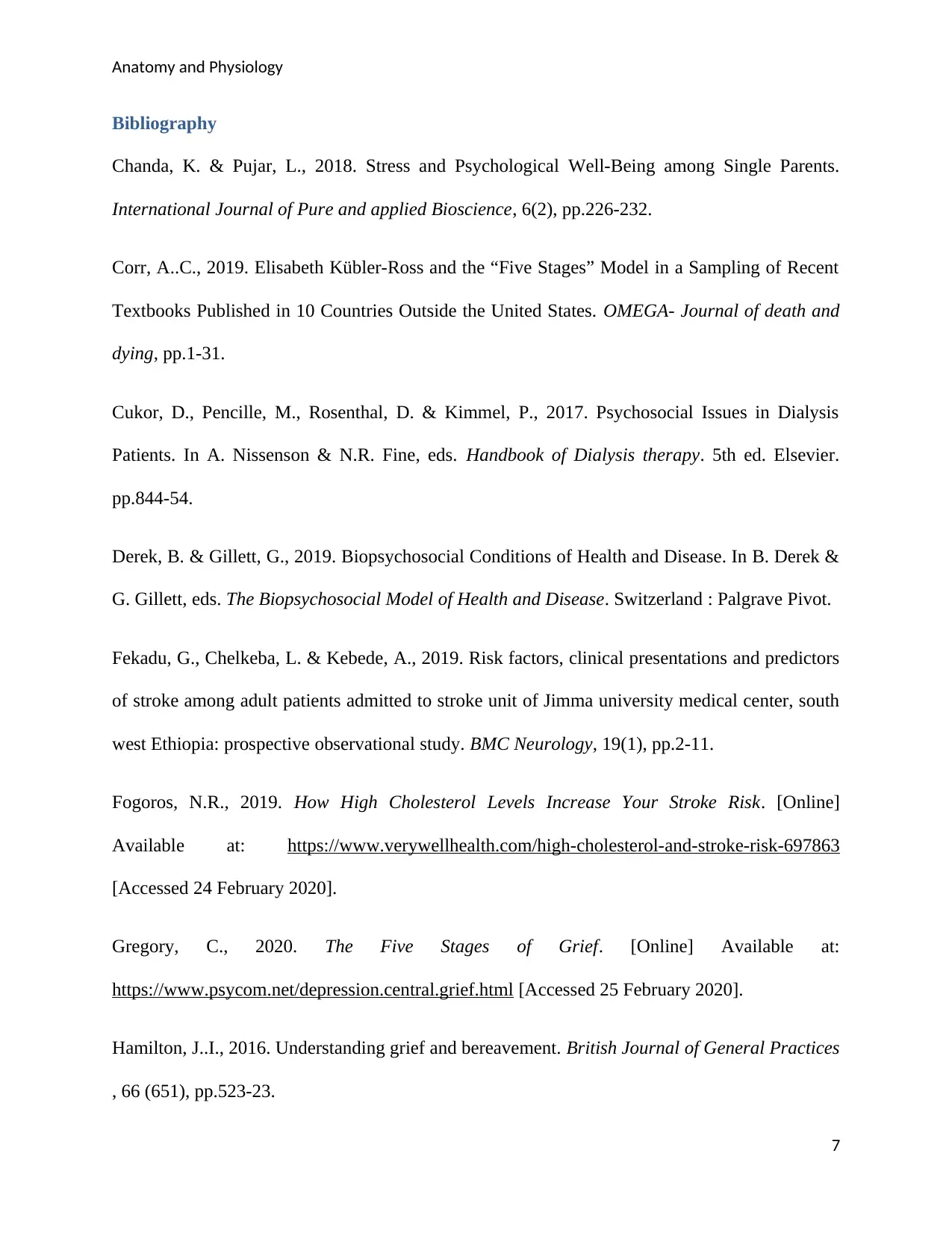
Anatomy and Physiology
Bibliography
Chanda, K. & Pujar, L., 2018. Stress and Psychological Well-Being among Single Parents.
International Journal of Pure and applied Bioscience, 6(2), pp.226-232.
Corr, A..C., 2019. Elisabeth Kübler-Ross and the “Five Stages” Model in a Sampling of Recent
Textbooks Published in 10 Countries Outside the United States. OMEGA- Journal of death and
dying, pp.1-31.
Cukor, D., Pencille, M., Rosenthal, D. & Kimmel, P., 2017. Psychosocial Issues in Dialysis
Patients. In A. Nissenson & N.R. Fine, eds. Handbook of Dialysis therapy. 5th ed. Elsevier.
pp.844-54.
Derek, B. & Gillett, G., 2019. Biopsychosocial Conditions of Health and Disease. In B. Derek &
G. Gillett, eds. The Biopsychosocial Model of Health and Disease. Switzerland : Palgrave Pivot.
Fekadu, G., Chelkeba, L. & Kebede, A., 2019. Risk factors, clinical presentations and predictors
of stroke among adult patients admitted to stroke unit of Jimma university medical center, south
west Ethiopia: prospective observational study. BMC Neurology, 19(1), pp.2-11.
Fogoros, N.R., 2019. How High Cholesterol Levels Increase Your Stroke Risk. [Online]
Available at: https://www.verywellhealth.com/high-cholesterol-and-stroke-risk-697863
[Accessed 24 February 2020].
Gregory, C., 2020. The Five Stages of Grief. [Online] Available at:
https://www.psycom.net/depression.central.grief.html [Accessed 25 February 2020].
Hamilton, J..I., 2016. Understanding grief and bereavement. British Journal of General Practices
, 66 (651), pp.523-23.
7
Bibliography
Chanda, K. & Pujar, L., 2018. Stress and Psychological Well-Being among Single Parents.
International Journal of Pure and applied Bioscience, 6(2), pp.226-232.
Corr, A..C., 2019. Elisabeth Kübler-Ross and the “Five Stages” Model in a Sampling of Recent
Textbooks Published in 10 Countries Outside the United States. OMEGA- Journal of death and
dying, pp.1-31.
Cukor, D., Pencille, M., Rosenthal, D. & Kimmel, P., 2017. Psychosocial Issues in Dialysis
Patients. In A. Nissenson & N.R. Fine, eds. Handbook of Dialysis therapy. 5th ed. Elsevier.
pp.844-54.
Derek, B. & Gillett, G., 2019. Biopsychosocial Conditions of Health and Disease. In B. Derek &
G. Gillett, eds. The Biopsychosocial Model of Health and Disease. Switzerland : Palgrave Pivot.
Fekadu, G., Chelkeba, L. & Kebede, A., 2019. Risk factors, clinical presentations and predictors
of stroke among adult patients admitted to stroke unit of Jimma university medical center, south
west Ethiopia: prospective observational study. BMC Neurology, 19(1), pp.2-11.
Fogoros, N.R., 2019. How High Cholesterol Levels Increase Your Stroke Risk. [Online]
Available at: https://www.verywellhealth.com/high-cholesterol-and-stroke-risk-697863
[Accessed 24 February 2020].
Gregory, C., 2020. The Five Stages of Grief. [Online] Available at:
https://www.psycom.net/depression.central.grief.html [Accessed 25 February 2020].
Hamilton, J..I., 2016. Understanding grief and bereavement. British Journal of General Practices
, 66 (651), pp.523-23.
7
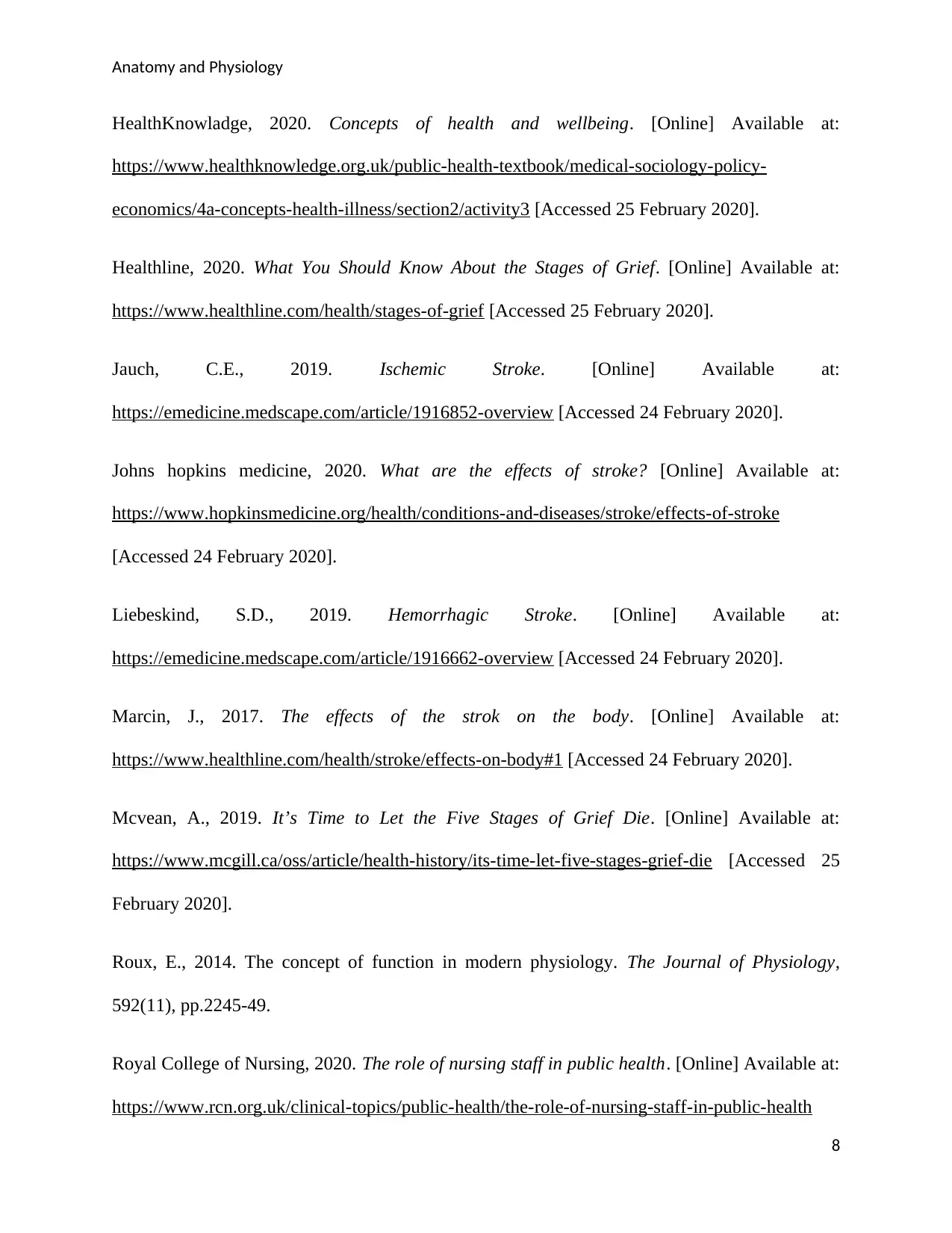
Anatomy and Physiology
HealthKnowladge, 2020. Concepts of health and wellbeing. [Online] Available at:
https://www.healthknowledge.org.uk/public-health-textbook/medical-sociology-policy-
economics/4a-concepts-health-illness/section2/activity3 [Accessed 25 February 2020].
Healthline, 2020. What You Should Know About the Stages of Grief. [Online] Available at:
https://www.healthline.com/health/stages-of-grief [Accessed 25 February 2020].
Jauch, C.E., 2019. Ischemic Stroke. [Online] Available at:
https://emedicine.medscape.com/article/1916852-overview [Accessed 24 February 2020].
Johns hopkins medicine, 2020. What are the effects of stroke? [Online] Available at:
https://www.hopkinsmedicine.org/health/conditions-and-diseases/stroke/effects-of-stroke
[Accessed 24 February 2020].
Liebeskind, S.D., 2019. Hemorrhagic Stroke. [Online] Available at:
https://emedicine.medscape.com/article/1916662-overview [Accessed 24 February 2020].
Marcin, J., 2017. The effects of the strok on the body. [Online] Available at:
https://www.healthline.com/health/stroke/effects-on-body#1 [Accessed 24 February 2020].
Mcvean, A., 2019. It’s Time to Let the Five Stages of Grief Die. [Online] Available at:
https://www.mcgill.ca/oss/article/health-history/its-time-let-five-stages-grief-die [Accessed 25
February 2020].
Roux, E., 2014. The concept of function in modern physiology. The Journal of Physiology,
592(11), pp.2245-49.
Royal College of Nursing, 2020. The role of nursing staff in public health. [Online] Available at:
https://www.rcn.org.uk/clinical-topics/public-health/the-role-of-nursing-staff-in-public-health
8
HealthKnowladge, 2020. Concepts of health and wellbeing. [Online] Available at:
https://www.healthknowledge.org.uk/public-health-textbook/medical-sociology-policy-
economics/4a-concepts-health-illness/section2/activity3 [Accessed 25 February 2020].
Healthline, 2020. What You Should Know About the Stages of Grief. [Online] Available at:
https://www.healthline.com/health/stages-of-grief [Accessed 25 February 2020].
Jauch, C.E., 2019. Ischemic Stroke. [Online] Available at:
https://emedicine.medscape.com/article/1916852-overview [Accessed 24 February 2020].
Johns hopkins medicine, 2020. What are the effects of stroke? [Online] Available at:
https://www.hopkinsmedicine.org/health/conditions-and-diseases/stroke/effects-of-stroke
[Accessed 24 February 2020].
Liebeskind, S.D., 2019. Hemorrhagic Stroke. [Online] Available at:
https://emedicine.medscape.com/article/1916662-overview [Accessed 24 February 2020].
Marcin, J., 2017. The effects of the strok on the body. [Online] Available at:
https://www.healthline.com/health/stroke/effects-on-body#1 [Accessed 24 February 2020].
Mcvean, A., 2019. It’s Time to Let the Five Stages of Grief Die. [Online] Available at:
https://www.mcgill.ca/oss/article/health-history/its-time-let-five-stages-grief-die [Accessed 25
February 2020].
Roux, E., 2014. The concept of function in modern physiology. The Journal of Physiology,
592(11), pp.2245-49.
Royal College of Nursing, 2020. The role of nursing staff in public health. [Online] Available at:
https://www.rcn.org.uk/clinical-topics/public-health/the-role-of-nursing-staff-in-public-health
8
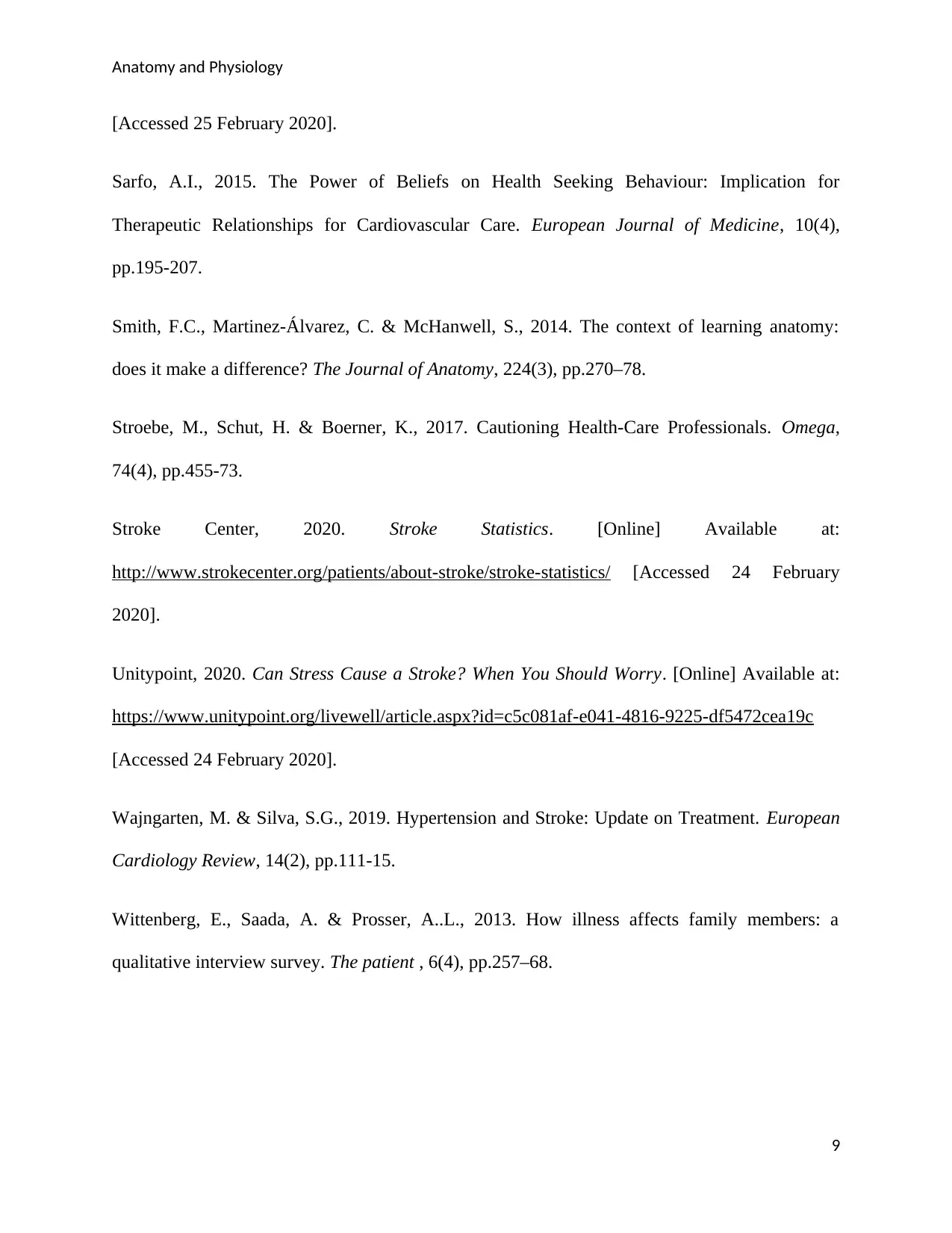
Anatomy and Physiology
[Accessed 25 February 2020].
Sarfo, A.I., 2015. The Power of Beliefs on Health Seeking Behaviour: Implication for
Therapeutic Relationships for Cardiovascular Care. European Journal of Medicine, 10(4),
pp.195-207.
Smith, F.C., Martinez-Álvarez, C. & McHanwell, S., 2014. The context of learning anatomy:
does it make a difference? The Journal of Anatomy, 224(3), pp.270–78.
Stroebe, M., Schut, H. & Boerner, K., 2017. Cautioning Health-Care Professionals. Omega,
74(4), pp.455-73.
Stroke Center, 2020. Stroke Statistics. [Online] Available at:
http://www.strokecenter.org/patients/about-stroke/stroke-statistics/ [Accessed 24 February
2020].
Unitypoint, 2020. Can Stress Cause a Stroke? When You Should Worry. [Online] Available at:
https://www.unitypoint.org/livewell/article.aspx?id=c5c081af-e041-4816-9225-df5472cea19c
[Accessed 24 February 2020].
Wajngarten, M. & Silva, S.G., 2019. Hypertension and Stroke: Update on Treatment. European
Cardiology Review, 14(2), pp.111-15.
Wittenberg, E., Saada, A. & Prosser, A..L., 2013. How illness affects family members: a
qualitative interview survey. The patient , 6(4), pp.257–68.
9
[Accessed 25 February 2020].
Sarfo, A.I., 2015. The Power of Beliefs on Health Seeking Behaviour: Implication for
Therapeutic Relationships for Cardiovascular Care. European Journal of Medicine, 10(4),
pp.195-207.
Smith, F.C., Martinez-Álvarez, C. & McHanwell, S., 2014. The context of learning anatomy:
does it make a difference? The Journal of Anatomy, 224(3), pp.270–78.
Stroebe, M., Schut, H. & Boerner, K., 2017. Cautioning Health-Care Professionals. Omega,
74(4), pp.455-73.
Stroke Center, 2020. Stroke Statistics. [Online] Available at:
http://www.strokecenter.org/patients/about-stroke/stroke-statistics/ [Accessed 24 February
2020].
Unitypoint, 2020. Can Stress Cause a Stroke? When You Should Worry. [Online] Available at:
https://www.unitypoint.org/livewell/article.aspx?id=c5c081af-e041-4816-9225-df5472cea19c
[Accessed 24 February 2020].
Wajngarten, M. & Silva, S.G., 2019. Hypertension and Stroke: Update on Treatment. European
Cardiology Review, 14(2), pp.111-15.
Wittenberg, E., Saada, A. & Prosser, A..L., 2013. How illness affects family members: a
qualitative interview survey. The patient , 6(4), pp.257–68.
9
Secure Best Marks with AI Grader
Need help grading? Try our AI Grader for instant feedback on your assignments.
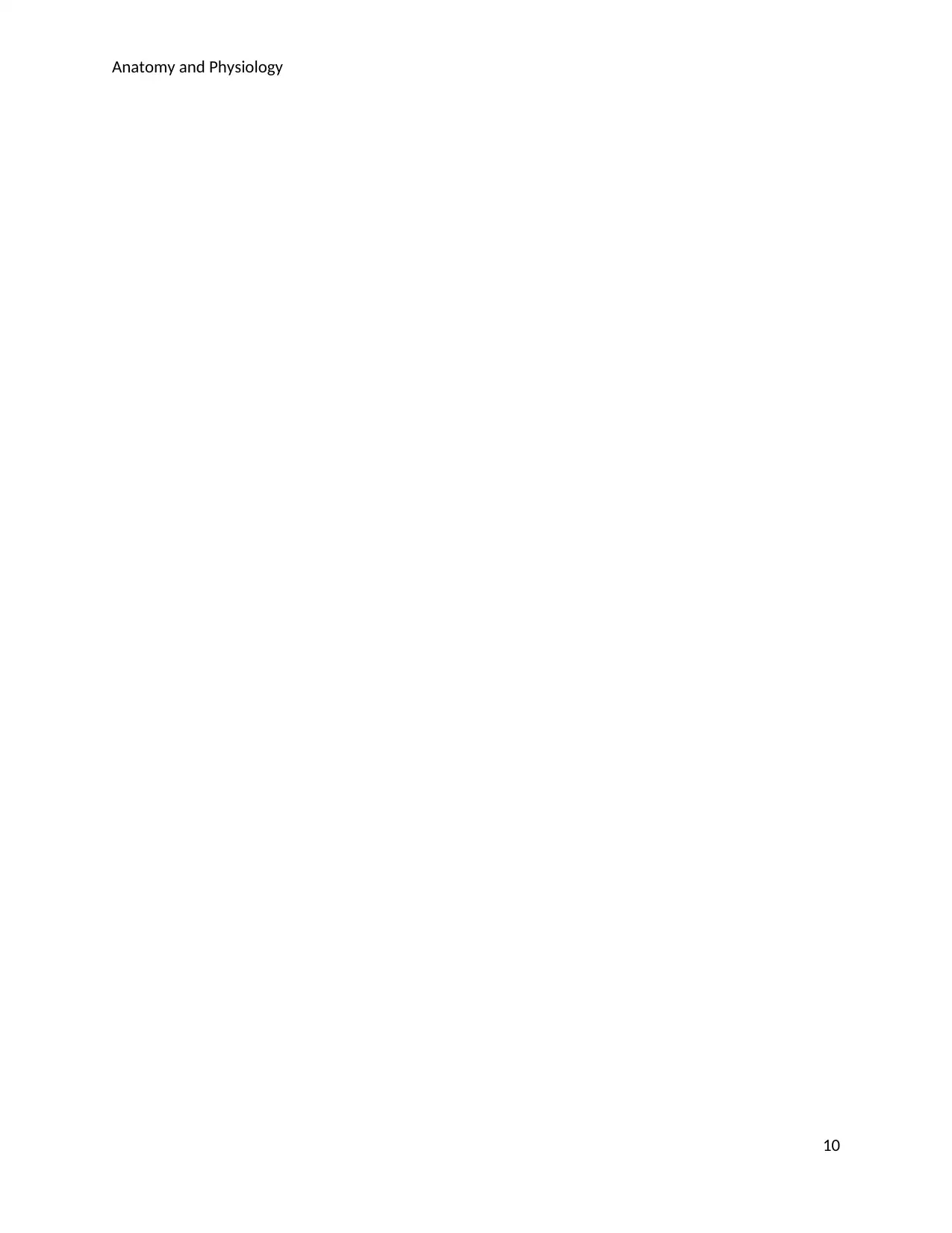
Anatomy and Physiology
10
10
1 out of 11
Related Documents
Your All-in-One AI-Powered Toolkit for Academic Success.
+13062052269
info@desklib.com
Available 24*7 on WhatsApp / Email
![[object Object]](/_next/static/media/star-bottom.7253800d.svg)
Unlock your academic potential
© 2024 | Zucol Services PVT LTD | All rights reserved.





